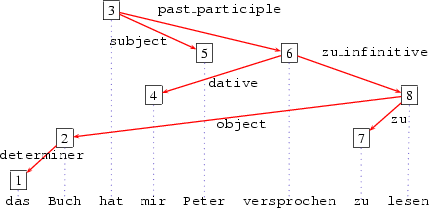5.1 Overview
We hope that the fundamentals of DG are known to the reader. We review the basic ideas only very briefly.
Contrary to phrase structure grammar, where parse trees consist mostly of non-terminal nodes and words appear only as leaves, dependency grammar postulates no non-terminals: words are in bijection with the nodes of the dependency tree. In other words, edges are drawn directly between words. Thus a finite verb has typically an edge directed to its subject, and another to its object.
Unlike traditional phrase structure trees, dependency trees usually allow crossing branches. This makes dependency trees rather attractive for languages with free word order (e.g. German), and for the representation of long distance dependencies. As an illustration, consider the dependency tree shown below:

Each box represents a node in the dependency tree. For ease of reading, the words are written at the bottom and for each one the corresponding node is indicated by connecting it to the word by a vertical dotted blue line. Also each box contains an integer indicating the position of the word in the input. The directed edges of the dependency tree are represented by red arrows. Each arrow is labeled to indicate the type of the dependency, for example by subject or zu_infinitive. We call such labels roles. These roles are purely syntactic and not to be confused e.g. with thematic roles.